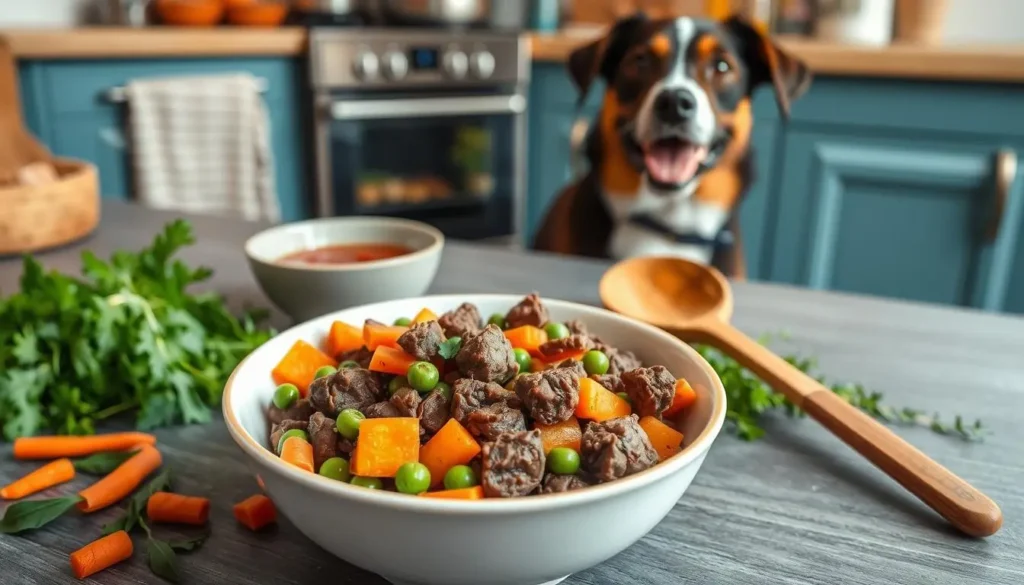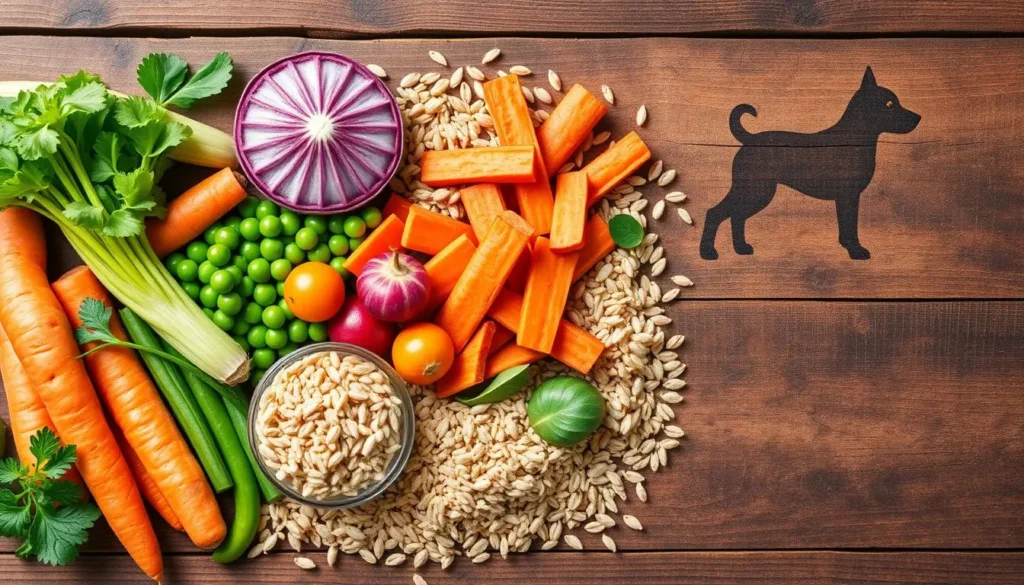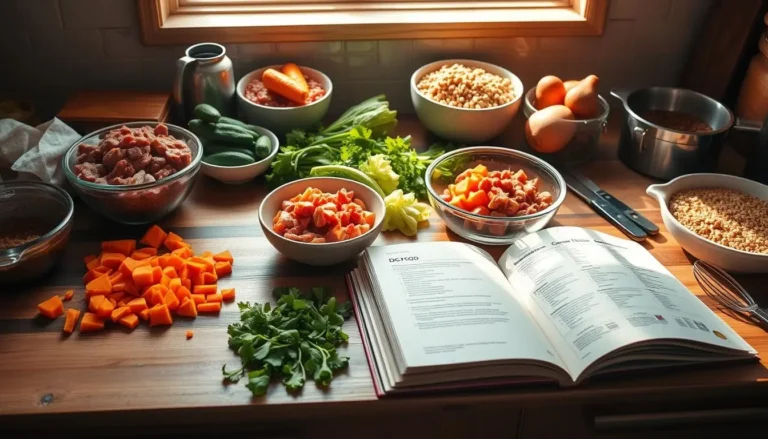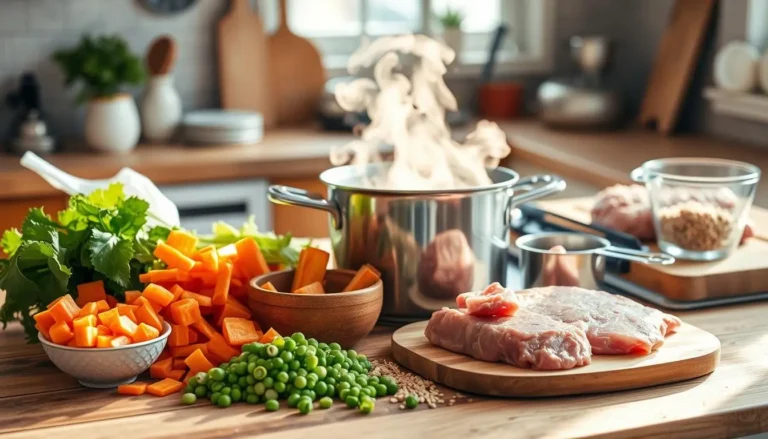Dog Home Food: Easy and Healthy Recipes for Your Furry Friend

More and more pet owners are choosing homemade dog food for their pets. It’s a way to ensure your dog gets the best nutrition. A good homemade dog food plan can really improve your dog’s health.
When you make dog home food, you pick every ingredient. This means your dog gets meals that are both healthy and tasty. Unlike store-bought dog food, homemade meals can be tailored to fit your dog’s needs.
Vets are now suggesting homemade meals for dogs. They help keep your dog healthy for a long time. By using fresh ingredients, you can make meals that boost your dog’s energy and health.
Table of Contents
Key Takeaways
- Homemade dog food offers personalized nutrition
- Control ingredient quality and source
- Address specific health needs through diet
- Potentially improve dog’s energy and wellness
- Cost-effective alternative to premium commercial foods
Understanding the Benefits of Homemade Dog Food
Making homemade dog food is more than cooking. It’s a way to ensure your dog’s health and happiness. By learning to make homemade dog food, you gain access to nutrients that commercial foods often lack.
When you cook for your dog, you control their diet. Commercial dog foods often have fillers, preservatives, and low-quality ingredients. These might not be good for your dog’s health in the long run.
Nutritional Advantages Over Commercial Food
- Fresh, whole ingredients provide superior nutrient absorption
- Customizable recipes tailored to your dog’s specific health needs
- Elimination of unnecessary additives and preservatives
- Higher protein quality compared to processed foods
Cost-Effectiveness of Home Cooking
Many think making homemade dog food is expensive. But, it can actually save money. Buying ingredients in bulk and planning meals can cut down on costs.
| Food Type | Average Monthly Cost | Nutritional Quality |
|---|---|---|
| Commercial Dog Food | $50-$100 | Medium |
| Homemade Dog Food | $40-$80 | High |
Quality Control Benefits
With homemade dog food senior, you’re in charge of quality. You can pick the best ingredients, avoid allergens, and tailor recipes to your dog’s needs.
“Nutrition is the foundation of health for both humans and their canine companions.” – Veterinary Nutrition Expert
Spending time on homemade meals is more than just feeding your dog. It’s about caring for their health and happiness for years to come.
Essential Nutrients Your Dog Needs Daily
Knowing what foods are good for dogs starts with understanding the key nutrients they need. Dogs need a balanced diet with six main nutrient groups. These nutrients support their health and boost their energy.
- Proteins: The building blocks of muscle and tissue repair
- Carbohydrates: Primary energy source for daily activities
- Fats: Support skin, coat health, and provide concentrated energy
- Vitamins: Support metabolic processes and immune function
- Minerals: Essential for bone strength and cellular operations
- Water: Critical for hydration and all bodily functions
“Nutrition is the foundation of your dog’s health and longevity.” – Veterinary Nutrition Experts
When looking for good foods for dogs, choose whole, nutrient-rich ingredients. These provide a wide range of nutrients.
| Nutrient | Key Sources | Primary Function |
|---|---|---|
| Protein | Chicken, Fish, Lean Beef | Muscle Development |
| Carbohydrates | Brown Rice, Sweet Potatoes | Energy Production |
| Fats | Salmon Oil, Chicken Fat | Coat and Skin Health |
Understanding these essential nutrients helps you make balanced, nutritious meals. These meals support your dog’s health from puppyhood to senior years.
Kitchen Tools and Equipment for Making Dog Food
Preparing homemade dog food needs more than just ingredients. The right kitchen tools make the process easier, safer, and more efficient. Quality equipment helps you create nutritious meals for your furry friend with confidence.
When you start making homemade dog food, you’ll need a set of kitchen tools. These tools are designed to support your pet’s nutritional needs.
Essential Cooking Equipment
- Large stainless steel stockpot for batch cooking
- High-quality food processor for ingredient preparation
- Sharp chef’s knife for precise cutting
- Measuring cups and kitchen scale for accurate portioning
Storage and Portioning Tools
Proper storage is key when making homemade dog food. Here are the essential tools:
| Tool | Purpose |
|---|---|
| Portion control containers | Divide meals into precise servings |
| Airtight glass containers | Keep food fresh in refrigerator |
| Freezer-safe meal prep containers | Store bulk batches for future use |
Food Safety Essentials
Keeping things clean is crucial when preparing homemade dog food. Here are the critical food safety tools:
- Digital meat thermometer
- Separate cutting boards for meat and vegetables
- Food-grade sanitizing solution
- Disposable gloves
“The right tools transform home cooking from a challenge to a joy – for both you and your dog.”
By having these specialized tools in your kitchen, you’re ready to make nutritious, safe, and delicious meals. These meals will support your dog’s health through homemade dog food.
Safe and Harmful Ingredients for Dog Home Food
Creating dog home food needs careful picking of ingredients to keep your pet healthy. Knowing how to make homemade dog food for dogs is key to making nutritious meals. These meals should support your dog’s health and well-being.
Some ingredients are great for dogs, while others are harmful. Let’s look at the good and bad of canine nutrition.
Safe Ingredients for Dogs
- Lean meats (chicken, turkey, beef)
- Cooked fish like salmon
- Sweet potatoes
- Carrots
- Pumpkin
- Brown rice
- Eggs
Dangerous Foods to Avoid
- Chocolate
- Onions and garlic
- Grapes and raisins
- Macadamia nuts
- Xylitol (artificial sweetener)
- Avocado
- Alcohol
Pro Tip: Talk to your vet before making major changes to your dog’s diet.
“Nutrition is the foundation of your dog’s health. Choose ingredients wisely.” – Veterinary Nutrition Expert
Nutritional Balance Considerations
| Nutrient | Daily Requirement | Best Sources |
|---|---|---|
| Protein | 18-25% of diet | Chicken, beef, fish |
| Fat | 10-15% of diet | Salmon, chicken fat |
| Carbohydrates | 30-50% of diet | Brown rice, sweet potatoes |
When making dog home food, balance is crucial. Each ingredient should help make a complete nutritional mix. This blend fuels energy, supports muscle strength, and promotes overall health.
Basic Chicken and Rice Recipe for Dogs
Making your own dog home food can really help your pet’s health. A mix of chicken and rice gives them key nutrients. It’s a great choice instead of store-bought pet food.
Creating healthy dog food means picking the right ingredients and cooking them right. Let’s look at what makes this meal so good for your dog.
Ingredient List and Portions
- 2 cups cooked chicken (boneless, skinless)
- 1 cup brown rice
- 1/2 cup mixed vegetables (carrots, green beans)
- 2 tablespoons olive oil
- 1/4 teaspoon calcium supplement
| Dog Weight | Daily Portion |
|---|---|
| 10-25 lbs | 1-1.5 cups |
| 26-50 lbs | 2-3 cups |
| 51-75 lbs | 3-4 cups |
Cooking Instructions
- Cook chicken thoroughly, removing all bones
- Prepare brown rice according to package instructions
- Steam vegetables until soft
- Mix all ingredients together
- Add olive oil and calcium supplement
Storage and Serving Guidelines
Keep your homemade dog food in airtight containers. Store it in the fridge for 3-4 days or freeze for 2 months. Always serve it at room temperature. Talk to your vet about what’s best for your dog’s diet.
*”A nutritious homemade meal can significantly improve your dog’s health and energy levels.”*
Every dog is different. Change the recipe to fit your pet’s needs and health.
Beef and Vegetable Meal for Active Dogs

Making the right dog home food at home is key for your lively pet. They need a diet rich in protein and nutrients. This helps keep their energy up and supports muscle growth.
When making a beef and veggie meal, pick lean beef of high quality. The mix should have enough protein and healthy veggies. These veggies add vitamins and minerals.
“A well-balanced dog food recipe can transform your pet’s health and vitality.” – Veterinary Nutrition Experts
- Choose grass-fed, lean beef cuts
- Include nutrient-rich vegetables like:
- Carrots
- Spinach
- Sweet potatoes
- Avoid seasonings and added salt
Your homemade dog food must be complete nutritionally. Protein should make up about 25-30% of the meal. Vegetables add important micronutrients.
For the right amount of dog home food, talk to your vet. They can adjust the recipe based on your dog’s size, age, and how active they are. Active dogs usually need more protein and calories than less active ones.
Special Diet Recipes for Senior Dogs
Caring for an aging dog needs special nutrition. As your furry friend gets older, making homemade dog food is key. It helps keep them healthy and full of life. Senior dogs have unique dietary needs that require careful planning and the right ingredients.
Low-Fat Options for Older Dogs
Older dogs move less, so managing their weight is vital. Making low-fat homemade dog home food helps avoid obesity. It also supports their overall health. Here are some tips:
- Use lean protein sources like skinless chicken breast
- Add steamed vegetables for bulk without extra calories
- Limit fatty meats and avoid too much oil
Joint-Supporting Ingredients
Senior dogs often have joint issues. Your homemade dog food can include ingredients that help with mobility and reduce swelling:
- Omega-3 rich fish like salmon
- Bone broth for natural glucosamine
- Turmeric as a natural anti-inflammatory
Digestive-Friendly Combinations
Older dogs often have sensitive stomachs. Make meals that are easy on their stomach but still nutritious:
- Easily digestible proteins like boiled chicken
- Pumpkin for digestive health
- Probiotic-rich ingredients to support gut health
“Proper nutrition underpins good health for older dogs. Thoughtful, tailored meals can dramatically improve their quality of life.” – Veterinary Nutrition Expert
Fish-Based Recipes for Coat Health
Learning to make homemade dog food with fish can greatly improve your dog’s coat. Fish recipes are full of omega-3 fatty acids. These acids make your dog’s coat shiny and support their skin health.
Salmon and sardines are great choices for your dog’s meals. They are rich in nutrients and healthy fats. These help your dog’s coat look radiant and keep their immune system strong.
“A diet rich in omega-3s can transform your dog’s coat from dull to dazzling” – Veterinary Nutrition Experts
Here are the main benefits of fish in your dog’s homemade food:
- Reduces skin inflammation
- Enhances coat shine and texture
- Supports joint health
- Boosts immune system function
When making homemade dog food with fish, remember these tips:
- Choose fresh, high-quality fish
- Remove all bones carefully
- Cook thoroughly to eliminate potential parasites
- Incorporate dog-safe vegetables for balanced nutrition
Pro tip: Start with small fish portions and gradually increase to ensure your dog tolerates the new protein source.
Vegetarian Dog Food Options
Looking into vegetarian diets for dogs needs careful planning. This helps guarantee your pet receives all the necessary nutrients. Many pet owners choose these diets instead of traditional meat-based ones.

Dogs are omnivores, so they consume both plant and animal foods. They have special nutritional needs that can be hard to meet with just plants. Veterinary nutritionists say it’s important to plan well to keep your dog healthy on a vegetarian diet.
Protein Alternatives for Dogs
It’s key to find good protein sources for dogs on a vegetarian diet. Here are some high-quality options:
- Eggs (complete protein source)
- Lentils and beans
- Quinoa
- Tofu
- Greek yogurt
Complete Nutrient Profile
A balanced vegetarian diet must have all the nutrients found in meat. Dogs need certain amino acids and vitamins to stay healthy.
| Nutrient | Plant-Based Sources | Daily Requirement |
|---|---|---|
| Protein | Legumes, Quinoa | 18-25% of diet |
| Vitamin B12 | Fortified nutritional yeast | 2.4 mcg daily |
| Iron | Spinach, Lentils | 100-180 mg daily |
Recipe Variations
Make meals exciting for your dog with vegetarian options. Rotate ingredients to keep things interesting and ensure they get all the nutrients they need.
“Careful planning transforms vegetarian dog food from a challenge to a nutritional opportunity.” – Veterinary Nutrition Expert
Always talk to your vet before switching to a vegetarian diet. Some dogs might need supplements to get all the nutrients they need on a plant-based diet.
Portion Control and Feeding Schedule
Creating the perfect dog home food meal plan is all about portion sizes and feeding schedules. Your dog’s nutritional needs change based on several key factors. This makes it important to tailor portion control for their health.
Finding the right amount of dog home food involves several important elements:
- Dog’s current weight
- Age and activity level
- Metabolic rate
- Overall health condition
Weight management starts with precise measurements. Veterinarians recommend calculating daily calorie needs based on your dog’s ideal body weight. Here’s a quick guide to help you portion your dog home food effectively:
| Dog Size | Daily Calories | Meal Frequency |
|---|---|---|
| Small Breeds (10 lbs) | 300-400 calories | 2-3 small meals |
| Medium Breeds (30-50 lbs) | 700-900 calories | 2 balanced meals |
| Large Breeds (70-90 lbs) | 1200-1500 calories | 2 substantial meals |
“Consistency is key in dog nutrition. Regular feeding times help regulate metabolism and prevent unnecessary weight gain.” – Veterinary Nutrition Expert
When starting your dog on dog home food, introduce portions gradually. Start by mixing new homemade meals with their current food. Slowly increase the homemade portion over 7-10 days. This helps prevent digestive issues and lets your dog get used to the new diet.
Monitor your dog’s weight and energy levels. Adjust portions as needed. Always talk to your vet to make sure your dog home food is complete and balanced.
Storage Tips and Meal Prep Strategies
Learning to make homemade dog food means you need to focus on storage and meal prep. These steps are key to keeping your dog’s food fresh and safe. Planning ahead can save you time and make sure your dog eats healthy, fresh meals.
When you make homemade dog food, you must pay attention to how you store and plan meals. The right methods help keep nutrients in and reduce waste.
Freezing Methods for Homemade Dog Meals
Freezing is a great way to make meals ahead of time. Here are some important tips:
- Use airtight, freezer-safe containers
- Portion meals into individual serving sizes
- Label containers with preparation date
- Use within 2-3 months for best quality
Thawing Guidelines
Thawing homemade dog food safely is important. It keeps the food nutritious and prevents harmful bacteria:
- Transfer frozen meals to the refrigerator
- Allow 24 hours for complete thawing
- Use thawed food within 48 hours
- Never refreeze thawed dog food
Weekly Meal Planning Strategies
| Day | Meal Preparation Task | Time Required |
|---|---|---|
| Sunday | Batch cooking and portioning | 2-3 hours |
| Mid-Week | Check and rotate frozen meals | 30 minutes |
| Weekly | Inventory ingredient supplies | 15 minutes |
“Proper preparation is the key to successful homemade dog food nutrition.” – Veterinary Nutrition Expert
Getting good at making homemade dog food takes time and organization. With these tips, you can give your dog consistent, healthy meals.
Conclusion
Making homemade dog food is more than cooking. It’s a way to care for your pet’s health and happiness. You can turn your kitchen into a place where your dog thrivesHow do I transition my dog to homemade food?.
Senior dogs need special care in their diet. A homemade diet can help with health issues and keep their energy up. Each meal is a chance to make your dog’s life better with the right ingredients.
Every dog is different, and their diet needs can change. Always talk to a vet before starting homemade dog food. They can help make sure the meals are right for your dog’s health.
Your effort to make healthy meals shows how much you care for your dog. By doing this, you’re not just feeding them. You’re helping them stay healthy, one meal at a time.
FAQ
How much homemade dog food should I prepare at one time?
You can make enough food for 3-5 days and keep it in the fridge. For bigger batches, freeze parts to keep it fresh. Always split the daily food into 2-3 meals, based on your dog’s size and activity.
Are there any essential supplements I should add to homemade dog food?
Yes, you’ll need calcium and multivitamins for complete nutrition. Talk to your vet about the right supplements for your dog. They might need calcium, fish oil, and a dog-specific multivitamin.
How do I make sure my homemade dog food is nutritionally balanced?
Mix proteins, carbs, and veggies for a balanced diet. Aim for 50% protein, 25% veggies, and 25% carbs. Use a variety of ingredients and consult a vet nutritionist for a personalized meal plan.
Can I make homemade dog food for senior dogs?
Yes, but senior dogs need special care. Use low-fat proteins and easy-to-digest foods. Add omega-3s, glucosamine, and low-calorie foods to support their health.
What kitchen equipment do I need to prepare homemade dog food?
You’ll need a big pot, food processor, cutting board, and measuring cups. Also, get storage containers and a meat thermometer. Use separate boards for meats and veggies to keep food safe.
How long can I store homemade dog food?
Store it in the fridge for 3-5 days in airtight containers. Freeze it for up to 2-3 months for longer storage. Always label and thaw safely to keep food quality and safety.
Are there any foods I absolutely must avoid in homemade dog food?
Yes, avoid toxic foods like chocolate, grapes, raisins, onions, garlic, macadamia nuts, and xylitol. These can harm or even kill dogs. Always check ingredients and ask your vet if unsure.
What steps should I take to switch my dog to homemade meals?
Start by mixing homemade food with their current diet. Begin with 25% homemade and 75% current food. Gradually increase homemade food over 7-10 days. Watch for digestion and energy changes, and ask your vet if needed.


